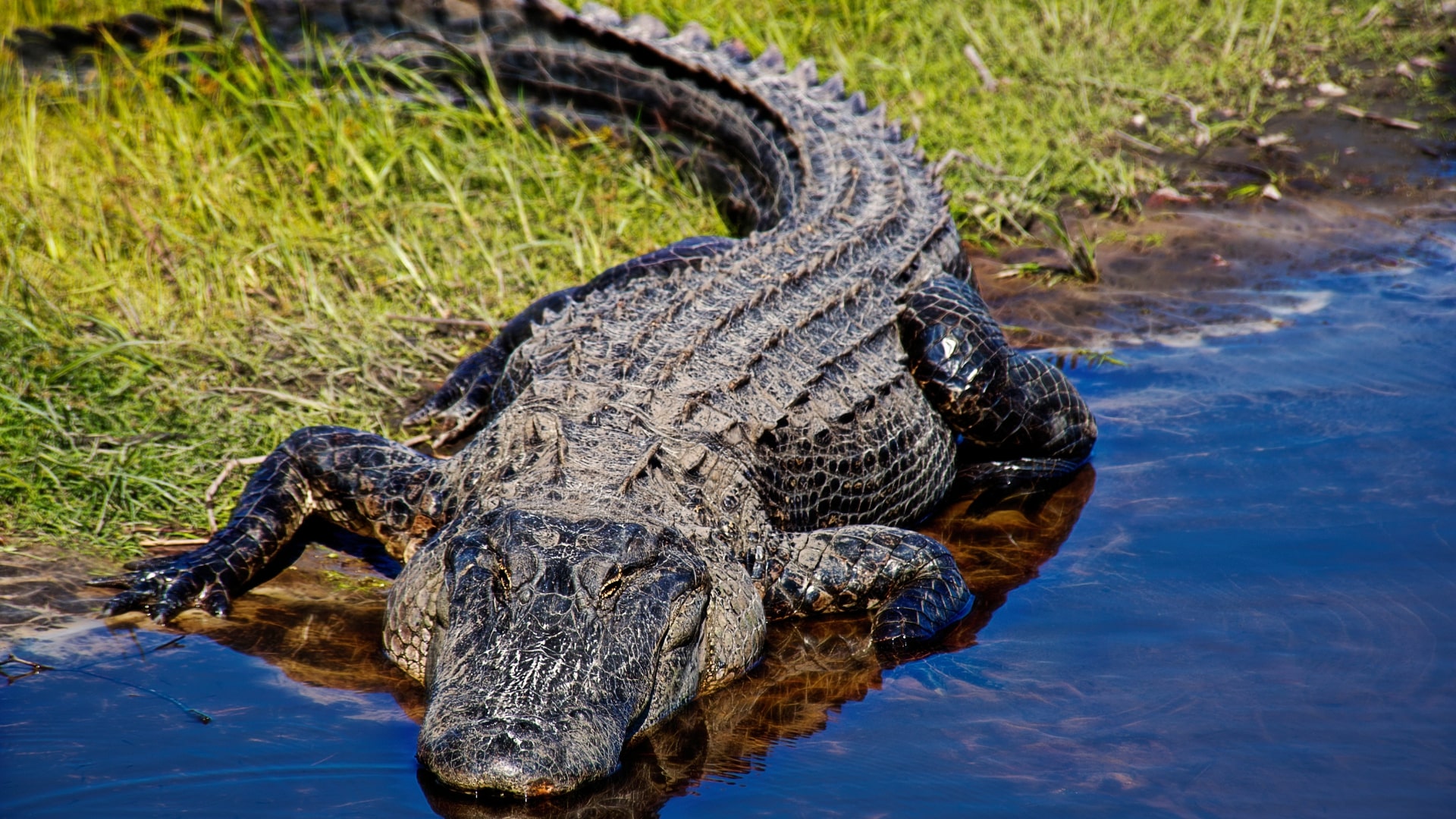Physical characteristics
Alligators (Alligator mississippiensis) are large, semi-aquatic reptiles that are part of the crocodilian family. They have a broad, flat head with a rounded snout, powerful jaws, and sharp teeth. Adult males can grow up to 14 feet (4.3 meters) long and weigh over 1,000 pounds (450 kilograms), while females are typically smaller, reaching up to 9 feet (2.7 meters) long and weighing around 200-250 pounds (90-113 kilograms).
Behavior
Alligators are primarily solitary animals that spend most of their time in the water. They are cold-blooded, which means that they regulate their body temperature by basking in the sun. They are also known for their ability to stay completely still for long periods of time, waiting for prey to come close enough to strike.
Habitat
They can be found in the southeastern United States, primarily in Florida and Louisiana, as well as in parts of Texas, Georgia, Alabama, Mississippi, and South Carolina. They prefer freshwater habitats such as swamps, marshes, lakes, and rivers, but can also be found in brackish water and occasionally in saltwater.
Diet
Alligators are carnivorous and will eat almost anything they can catch, including fish, turtles, birds, and small mammals. They are also known to attack larger prey such as deer, cattle, and even humans.
Breeding
Alligators mate during the spring and early summer, with females laying their eggs in a nest made of vegetation and mud. The eggs incubate for around 65 days, and the hatchlings are around 6-8 inches (15-20 centimeters) long and weigh just a few ounces.
Ecological role
These giant reptiles are important apex predators in their ecosystems, helping to regulate populations of prey species. They also create habitats for other species by digging holes and building nests, and their presence can help to maintain wetland ecosystems.
Alligator Hunting
Hunting gators is a regulated activity in the United States, primarily in the states of Florida, Louisiana, and Texas. It is considered a challenging and thrilling hunting experience, attracting many hunters each year.
Alligator hunting is typically done during a specific hunting season, which is strictly controlled and requires hunters to obtain permits or licenses. The hunting methods vary depending on the state and the specific regulations, but common methods include using baited hooks, harpoons, or firearms.
In some states, only designated alligator hunting zones are open for hunting, while in others, private landowners may allow hunting on their property. It is important for hunters to follow all regulations and safety guidelines, including using the proper equipment and techniques to avoid injury to themselves and the alligator.
Hunting alligators can also play a role in controlling alligator populations, as well as generating revenue for the states through licensing fees and taxes on equipment sales.
However, hunting alligators can also pose a risk to the conservation of the species, as over-hunting can lead to a decline in population numbers. Therefore, it is crucial for alligator hunting to be carefully monitored and regulated to ensure the sustainability of the species.
Tracks & Signs
Alligator tracks can be easily recognized by their unique characteristics. Their large, webbed feet leave imprints that resemble the outline of a flower. These tracks typically show three distinct claw marks on both the front and hind feet. The size of the tracks can vary, depending on the age and size of the alligator. Adult alligator tracks can measure up to a foot in length or more, leaving an impressive impression in the soft mud or sand.
Aside from tracks, gators leave behind a variety of signs that highlight their presence. One prominent indicator is the “slide mark,” which is a distinctive trail left by a gator as it slides into the water. These slides are created when the animal propels itself from land into the water, leaving behind a smooth, flattened area in the substrate. Look for these slide marks near the water’s edge, as alligators frequently slide in and out of their aquatic habitats.
Another significant sign of gator activity is the “mud mound.” Alligators construct mud mounds, or “gator nests” during the breeding season. These mounds serve as nests for females to lay their eggs. The nests are typically mound-shaped, constructed from vegetation, mud, and other available materials. The presence of these mud mounds indicates active breeding and nesting sites, offering a glimpse into the reproductive cycle of alligators.
Alligator scat, or feces, can also provide valuable information about their diet and presence in the area. Their scat is often cylindrical in shape, similar to that of other carnivorous reptiles. Depending on their diet, you may find remnants of fish, crustaceans, birds, small mammals, or even turtles within their scat. Examining the contents of gator scat can help you gain insights into their feeding habits and the availability of prey in the area.
Conservation
Alligator populations were once threatened due to overhunting and habitat destruction, but conservation efforts have been successful in bringing their numbers back up. Alligators are now listed as a species of least concern by the International Union for Conservation of Nature (IUCN).
Did You Know?
Alligators are living fossils!
They have been around for millions of years and have remained relatively unchanged since the time of the dinosaurs. These ancient creatures provide a fascinating glimpse into the prehistoric world.
They are excellent swimmers.
With their muscular tails and webbed feet, they can reach speeds of up to 20 miles per hour (32 kilometers per hour) in the water. Their streamlined bodies and powerful strokes allow them to navigate waterways with agility and precision.
Alligators are highly adaptable.
They can thrive in a variety of environments, including freshwater marshes, swamps, rivers, and even brackish estuaries. They have the ability to tolerate both saltwater and freshwater habitats, making them incredibly versatile and adaptable to changing conditions.
How fast can a gator run you ask?
Alligators can run up to 20 miles per hour sometimes reaching 30 miles per hour!
Alligators are social animals.
While they are typically solitary creatures, during the mating season, males engage in courtship displays to attract females. They also establish territories and communicate through various vocalizations, including hisses, roars, and bellows.
They possess an incredible bite force.
Their jaws are designed to clamp down with tremendous strength, exerting pressures of up to 2,980 pounds per square inch (20,586 kilopascals). This remarkable bite force allows them to capture and hold onto their prey securely.
Image sources: NatureTracking, Queensland Environment, Fine Art America, Winterberry Wildlife







